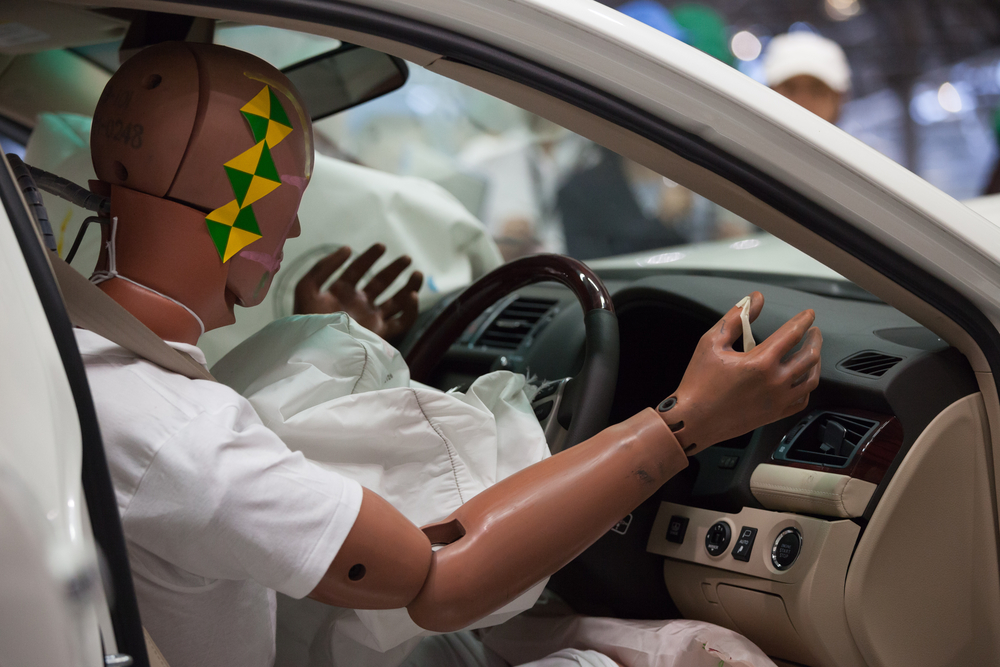
The first automobiles were developed in Europe in the late 1800s, but Americans quickly jumped into the automobile game. In 1893, two bicycle mechanics in Springfield, MA brought forth the first American gasoline-powered vehicle. Those early models bear little resemblance to the ones we drive today – and that’s nowhere more apparent than in safety standards.
In early days, drivers and passengers took their chances when climbing aboard these “contraptions” that resembled modern cars only in the fact there is a carriage with wheels and an engine. Luckily, top speeds in early autos were around 12 mph, but as they got faster, safety became a bigger concern.
Another essential safety feature of driving these days is car insurance. We know that having insurance, whether it be automobile, home, life or some other, helps protect us against the financial devastation that can follow an unexpected event. The first policy was written in 1897 and now is required in the United States.
Let’s take a look at how the vehicle you drive today and the safety features in new cars evolved.
Basic Safety Features
Basic features, such as turn signals, headlights and seatbelts, were nowhere to be found on early automobiles. The Ford Model T offered a windshield, headlights and a speedometer as optional add-ons. The Nash Rambler was ahead of its time, offering lap seat belts in 1950. The buying public, however, was not impressed and felt the belts were a nuisance. Nash only sold 1,000 seatbelt-equipped models. Volvo jumped in with a shoulder belt in 1959.
In 1966, the National Traffic and Motor Vehicle Safety Act passed, which, among other things, established a rulebook guiding construction called the Federal Motor Vehicle Safety Standards.
Wheels
Almost from the time people have moved things from one place to another, wheels have been involved. Wheels have a colorful history, including design and engineering that passed through the ancient Egyptians, the Greeks and the Celts.
More modern prototypes came around when Karl Benz came up with a spoked wire and hard-rubber tire for one of his early vehicles in 1885.
In the 1900s, Ford began with wooden wheels, but quickly moved to welded steel. As with many other automobile improvements, racing enthusiasts are responsible for wheels that employed aluminum-magnesium alloys. Today’s wheels are a marvel of modern technology, incorporating a variety of designs and materials.
In today’s parlance, the word wheel includes the hub, spokes, rim and, of course, the tire. The bigger the wheel, the larger the tire. Larger tires help your car grip the road better. And, of course, the steering wheel itself works better when the actual wheels are right.
Brakes
It could be argued that brakes are the most important safety feature on any forward- or rear-moving contraption. They certainly have their place in automotive safety. Unlike early iterations, which involved a wooden block hanging from a rope, once tires moved from wood and metal to rubber, brakes became a marvel of physics, using thermal energy to halt forward (or backward) progress.
Brake Lights
Many of the first drivers in the early 1900s felt that the use of hand signals was enough of a warning system to let others know their intentions. This may have worked when top speeds were 12 mph. As speeds increased, however, it became necessary to add new warning systems in the form of brake lights, and later, a turn signal. By 1928, brake requirements were mandatory in 11 states. The third brake light, invented by a psychologist who tested the gadget on taxis in San Francisco, has been responsible for a significant decrease in rear-end collisions.
Turn Signals
Although turn signals may have a lurid soap opera history (possibly invented by well-known actress Florence Lawrence, who failed to get a patent, then spiraled downhill with an unfortunate third marriage and later killed herself with ant poison), other sources credit John Hetrick. Hetrick was reportedly inspired to invent turn signals in 1939 after watching his son use flags to indicate which way he was going.
Luckily, turn signals are a boon to automotive safety. With this simple tool, drivers can communicate their intentions to those sharing the road. Various studies have shown a reduction in read-end and side impact crashes when drivers use their turn signal.
The only controversy ongoing is whether they should be red or amber (more of an orangey-yellow). The Department of Transportation (DOT) produced a National Highway Traffic Safety Administration (NHTSA) report making the case that amber lights work better than red ones. Automakers aren’t required at this point to use the color amber and are balking at the extra cost (although it’s not estimated to be much).
Seat Belts
Although they were invented in 1885, it wasn’t until 1968 that American-made models were required to have seat belts. These belts were mostly lap belts, which were later found to cause problems of their own (effectively cutting people in half in a collision). Later, three-point seat belts became the norm and, in most states, the “Click It or Ticket” law in 1995 made seatbelt use mandatory.
Believe it or not, for a short time, a federal law required that carmakers build ones that would not start unless seat belts were engaged. As expected, that did not go over well with Americans, and it was shortly repealed.
Miscellaneous Safety Features in Early Autos
We cannot move into newer, more modern cars without mentioning a few safety measures and equipment that were introduced in early days.
- Rearview mirror: In 1906, the author of the famous book The Woman and the Car: A Chatty Little Handbook for All Women Who Motor or Want to Motor, recommended that the ladies carry a handheld mirror so they could see what was behind them. In 1914, a patent was issued for a mirror attachment meant to help drivers avoid a blind spot. In the 1920s, Elmer Berger put his “Cop-Spotter” mirror attachment on the market. It was wildly successful, proving that some things never change.
- Rear bumper: Bumpers as a whole have had a storied history. In 1901, a rubber bumper designed to lessen impact was sent to the patent office and hit the market. In the 1910s, a strip of steel that fit across the front and back of the vehicle was introduced. Over the years, bumpers became more elaborate to result in today’s models which are plastic over steel, fiberglass, aluminum or plastic.

Crash Test Dummies
Before we move into new models, we must give a nod to Sierra Sam, the first crash test dummy invented for use by the US Air Force to test ejection seats in 1949. In 1997, crash test dummies became the first line of defense in testing how to make things safer and reduce injuries and fatalities around the world.
Many of your new standards (even if your ride is 20 years old) are there because of crash test dummies and what they have shown us about how the human body reacts to automobile crashes.
Top Safety Features in New Cars
The same public who decried various tentative attempts at safety measures in their automobiles in early days were responsible for many of the safety improvements we see today. As vehicles became faster, more common and more affordable, people became more vocal about the number of injuries and fatalities on American roads and highways.
As a result, the National Highway Traffic Safety Administration (NHTSA) was established under the National Traffic and Motor Vehicle Safety Act. The act gave the NHTSA the power to enforce safety standards and the use of standard equipment.
Many of the items you see on today’s automobiles are the result of NHTSA mandates. Let’s take a look at some of these critical additions.
Airbags
Automotive airbags came along in 1974 in the United States, although they were invented in the early 1950s. General Motors first installed them in a fleet of 1973 Chevrolet Impalas, used by the government. The 1973 Oldsmobile Toronado was first to market with passenger side airbags. Not surprisingly, Americans were not impressed with this additional (cost-adding) safety feature and it was shortly discontinued. Automakers were not impressed either and Ford and GM spent years (and money) lobbying against airbags.
In 1999, front airbags became mandatory. According to the Insurance Institute, airbags are a critical piece of safety in new cars. Their statistics say front airbags reduce driver fatalities in frontal crashes by 29%, while side airbags (still optional) reduce driver death in driver-side crashes by 37% and an SUV driver’s risk by 52%.
Anti-Lock Brakes
As mentioned above, brakes are a critical component to safety and manufacturers have been incorporating brake safety designs since the 1960s.
ABS technology made its debut in the 1960s and big names like Chrysler, Ford, Nissan and Toyota became fans in the 1970s. Mercedes-Benz was the first automaker to make anti-lock brakes (ABS) standard – in 1985. Anti-lock brakes replace the old method of pumping the brake pedal to avoid a skid and provide traction control when emergency braking is employed.
Other Safety Elements to Consider
Today’s autos come with a laundry list of ways manufacturers have complied (maybe reluctantly) with requirements to make people safer on the road. Some items you may see today include:
- Electronic Stability Control – Another addition to control your vehicle while in a skid is electronic stability control. ESC is now standard in America.
- Adaptive cruise control – Not available on all models yet, this nifty safety component has many different monikers, including smart cruise control and radar cruise control. Adaptive cruise control helps to regulate the speed of your vehicle using a variety of other components, including sensors, radar and cameras.
- Cameras – For the most part, cameras are used to provide rearview access, such as a backup camera. This helps the driver avoid backing into objects by using parking sensors.
- Lane departure warning – There are a variety of lane departure systems available in today’s rides. Different manufacturers have different names and even different purposes for these additions. Mainly, though, this technology is aimed at keeping your vehicle in its lane, so as to avoid a collision.
Advanced high-tech advanced systems have come a long way in recent years. This is a good thing when it comes to the public’s safety.
Do Safety Features in New Cars Make the Price Worth It?
For the most part, new advancements are worth the peace of mind that comes with knowing you are driving a modern marvel of safety technology that is available today. When you and your family get behind the wheel on American roads today, it is natural to want the best and most up-to-date proven technology.
Coming Attractions in Safety
It used to be that only luxury vehicles had the latest and greatest technology – and that’s still true for some bells and whistles. Currently available, but not standard technology, runs the gamut from mundane to wildly imaginative and includes:
- 360-degree (overhead vision) – This camera is mounted on top of the vehicle and shows everything surrounding you.
- Intersection scanning and AEB system – Part of the latest additions, autonomous emergency braking (AEB) systems help drivers avoid collisions, but now there is the coming added protection of intersection-scanning AEB. It can detect oncoming traffic approaching at intersections.
- Center airbags – This system deploys an air bag between the driver and front seat passenger to help avoid heads banging in a rollover.
- Night vision – Only available in luxury vehicles currently, night vision helps discern animals, offers pedestrian detection and other vehicles in the dark.
- Safety exit assist – Destined to be a huge hit with parents of young children, this sounds an alarm when a door is opened while other cars are approaching from behind.
Find Safety and Protection with the Best Auto Insurance Online Today
One thing we all want is to be safer on the road. Having the right insurance is a good way to make sure we are protected financially when we get behind the wheel. At Freeway Insurance, you can get a fast and free car insurance quote online, call us at 800-777-5620 or stop by one of our convenient locations.



